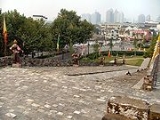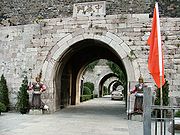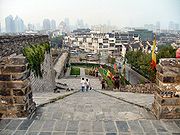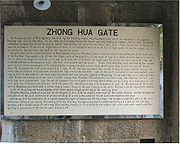
Gate of China, Nanjing
Encyclopedia
The Gate of China in Nanjing , was a ceremonial gateway in Nanjing
, China
. It was the southern gate of Nanjing
city. It is a renowned ancient city gate
in China
and the city gate with the most complex structure in the world.



 The city wall of Nanjing
The city wall of Nanjing
was built from 1360 to 1386 under the founder of the Ming dynasty
, the Hongwu Emperor
Zhu Yuanzhang. In 1368, Zhu Yuanzhang was crowned Emperor, and made Nanjing his capital. The southern and eastern sections of the old city wall from the Tang dynasty
were incorporated into the new wall. The northern and eastern sections were built afresh. The city wall was 33.676 kilometres long. It was 14–21 m high; 14.5m thick at its base, and 4.9m thick at the top. Thirteen gates were built into the wall, and the enclosed area was the largest of any walled city in China.
The gate today known as the Gate of China was then known as Jubao Gate . It was built on the site of the south gate of the capital city of the Southern Tang
dynasty. It was the largest among the thirteen gates of Nanjing. In 1931, after the Republic of China
government established Nanjing
as its capital, the gate was renamed the Gate of China. In one sense, this reflects the triumph of the southern factions led by Chiang Kai-shek
over the northern factions of the Beiyang government
in Beijing
, who had named the southern (main) gate of Beijing
"Gate of China
" to signify its status as "gate of the nation".
Its dimensions were 118.5 m from east to west, and 128 m from south to north. The ramparts were 20.45 m high. The total area enclosed was 15,168 square meters. Three barbican
s were connected by four arched gates, each of which was equipped with a Qianjinzha which could be opened up and down, as well as a pair of wooden doors. The Toudaomen consisted of 3 steps.
At the top step, there used to be a wooden building to defend against the enemy. The middle step was built of brick and stone. It was 65.15 m long, 47.20 m wide and 9.00 m high. In the north section of it were constructed 7 soldier staying holes. In the middle of the lower step was constructed an arched gate leading to barbican. It was 52.60 m long, 5.35 m wide and 8.7 m high. At the north section of it were built 3 soldier staying holes. Erdaomen (the second gate) was 16.14 m away from Toudaomen. Its hole was 8.20 m long, 4.97 m wide and 8.10 m high. The hole of Sandaomen (the third gate) 15.18 m away from Erdaomen was 8.32 m long, 4.82 m wide and 8.1 m high. Sidaomen (the fourth gate) was 19.3 m away from Sandaomen. Its hole was 8.8 m long, 4.8 m wide and 8.1 m high. At the outerside of the east and west of barbican were constructed 14 soldier staying holes (7 facing to the east 7 facing to the west). There are 27 soldier staying holes altogether in all the barbican and two paved patches from where soldiers can get up the top of the castle by horse.
The Gate of China has weathered wind and rain for 600 years. It still holds its original state except for the wooden structure had been destroyed and some features on the wall constructed of sticks and stones. It is rare in the world for its vast scale and sophisticated style.
Considering from the construction, it is a great engineering project of complex and intricate design, occupying an important place in the wall construction history in China. Considering from the military, the gate strength is good for the military operation and is a valuable sample for the study of Chinese military history. It was listed on the cultural and scenic spots under careful protection by Jiang Su government in 1957 and the state council in 1988.
Nanjing
' is the capital of Jiangsu province in China and has a prominent place in Chinese history and culture, having been the capital of China on several occasions...
, China
China
Chinese civilization may refer to:* China for more general discussion of the country.* Chinese culture* Greater China, the transnational community of ethnic Chinese.* History of China* Sinosphere, the area historically affected by Chinese culture...
. It was the southern gate of Nanjing
Nanjing
' is the capital of Jiangsu province in China and has a prominent place in Chinese history and culture, having been the capital of China on several occasions...
city. It is a renowned ancient city gate
City gate
A city gate is a gate which is, or was, set within a city wall. Other terms include port.-Uses:City gates were traditionally built to provide a point of controlled access to and departure from a walled city for people, vehicles, goods and animals...
in China
China
Chinese civilization may refer to:* China for more general discussion of the country.* Chinese culture* Greater China, the transnational community of ethnic Chinese.* History of China* Sinosphere, the area historically affected by Chinese culture...
and the city gate with the most complex structure in the world.
History




City Wall of Nanjing
The City Wall of Nanjing was designed by Emperor Zhu Yuanzhang after he founded the Ming Dynasty and established Nanjing as the capital 600 years ago. To consolidate his sovereignty and keep out invaders, he adopted the suggestions of advisor Zhu Sheng to build a higher city wall, to collect...
was built from 1360 to 1386 under the founder of the Ming dynasty
Ming Dynasty
The Ming Dynasty, also Empire of the Great Ming, was the ruling dynasty of China from 1368 to 1644, following the collapse of the Mongol-led Yuan Dynasty. The Ming, "one of the greatest eras of orderly government and social stability in human history", was the last dynasty in China ruled by ethnic...
, the Hongwu Emperor
Hongwu Emperor
The Hongwu Emperor , known variably by his given name Zhu Yuanzhang and by his temple name Taizu of Ming , was the founder and first emperor of the Ming Dynasty of China...
Zhu Yuanzhang. In 1368, Zhu Yuanzhang was crowned Emperor, and made Nanjing his capital. The southern and eastern sections of the old city wall from the Tang dynasty
Tang Dynasty
The Tang Dynasty was an imperial dynasty of China preceded by the Sui Dynasty and followed by the Five Dynasties and Ten Kingdoms Period. It was founded by the Li family, who seized power during the decline and collapse of the Sui Empire...
were incorporated into the new wall. The northern and eastern sections were built afresh. The city wall was 33.676 kilometres long. It was 14–21 m high; 14.5m thick at its base, and 4.9m thick at the top. Thirteen gates were built into the wall, and the enclosed area was the largest of any walled city in China.
The gate today known as the Gate of China was then known as Jubao Gate . It was built on the site of the south gate of the capital city of the Southern Tang
Southern Tang
Southern Tang was one of the Ten Kingdoms in south-central China created following the Tang Dynasty from 937-975. Southern Tang replaced the Wu Kingdom when Li Bian deposed the emperor Yang Pu....
dynasty. It was the largest among the thirteen gates of Nanjing. In 1931, after the Republic of China
Republic of China
The Republic of China , commonly known as Taiwan , is a unitary sovereign state located in East Asia. Originally based in mainland China, the Republic of China currently governs the island of Taiwan , which forms over 99% of its current territory, as well as Penghu, Kinmen, Matsu and other minor...
government established Nanjing
Nanjing
' is the capital of Jiangsu province in China and has a prominent place in Chinese history and culture, having been the capital of China on several occasions...
as its capital, the gate was renamed the Gate of China. In one sense, this reflects the triumph of the southern factions led by Chiang Kai-shek
Chiang Kai-shek
Chiang Kai-shek was a political and military leader of 20th century China. He is known as Jiǎng Jièshí or Jiǎng Zhōngzhèng in Mandarin....
over the northern factions of the Beiyang government
Beiyang Government
The Beiyang government or warlord government collectively refers to a series of military regimes that ruled from Beijing from 1912 to 1928 at Zhongnanhai. It was internationally recognized as the legitimate Government of the Republic of China. The name comes from the Beiyang Army which dominated...
in Beijing
Beijing
Beijing , also known as Peking , is the capital of the People's Republic of China and one of the most populous cities in the world, with a population of 19,612,368 as of 2010. The city is the country's political, cultural, and educational center, and home to the headquarters for most of China's...
, who had named the southern (main) gate of Beijing
Beijing
Beijing , also known as Peking , is the capital of the People's Republic of China and one of the most populous cities in the world, with a population of 19,612,368 as of 2010. The city is the country's political, cultural, and educational center, and home to the headquarters for most of China's...
"Gate of China
Gate of China, Beijing
The Gate of China in Beijing was a historical ceremonial gateway in Beijing, China, located near the centre of today's Tiananmen Square. It was demolished in 1954. This gate formed the southern gate of the Imperial City during the Ming and Qing dynasties. It was situated on the central axis of...
" to signify its status as "gate of the nation".
Layout
The gate was made of huge strip stones 0.8 – 1.39 m long, 0.7 m wide and 0.26-0.35 thick and large Chinese brick 0.4 m long 0.2 m wide and 0.1 m thick.Its dimensions were 118.5 m from east to west, and 128 m from south to north. The ramparts were 20.45 m high. The total area enclosed was 15,168 square meters. Three barbican
Barbican
A barbican, from medieval Latin barbecana, signifying the "outer fortification of a city or castle," with cognates in the Romance languages A barbican, from medieval Latin barbecana, signifying the "outer fortification of a city or castle," with cognates in the Romance languages A barbican, from...
s were connected by four arched gates, each of which was equipped with a Qianjinzha which could be opened up and down, as well as a pair of wooden doors. The Toudaomen consisted of 3 steps.
At the top step, there used to be a wooden building to defend against the enemy. The middle step was built of brick and stone. It was 65.15 m long, 47.20 m wide and 9.00 m high. In the north section of it were constructed 7 soldier staying holes. In the middle of the lower step was constructed an arched gate leading to barbican. It was 52.60 m long, 5.35 m wide and 8.7 m high. At the north section of it were built 3 soldier staying holes. Erdaomen (the second gate) was 16.14 m away from Toudaomen. Its hole was 8.20 m long, 4.97 m wide and 8.10 m high. The hole of Sandaomen (the third gate) 15.18 m away from Erdaomen was 8.32 m long, 4.82 m wide and 8.1 m high. Sidaomen (the fourth gate) was 19.3 m away from Sandaomen. Its hole was 8.8 m long, 4.8 m wide and 8.1 m high. At the outerside of the east and west of barbican were constructed 14 soldier staying holes (7 facing to the east 7 facing to the west). There are 27 soldier staying holes altogether in all the barbican and two paved patches from where soldiers can get up the top of the castle by horse.
The Gate of China has weathered wind and rain for 600 years. It still holds its original state except for the wooden structure had been destroyed and some features on the wall constructed of sticks and stones. It is rare in the world for its vast scale and sophisticated style.
Considering from the construction, it is a great engineering project of complex and intricate design, occupying an important place in the wall construction history in China. Considering from the military, the gate strength is good for the military operation and is a valuable sample for the study of Chinese military history. It was listed on the cultural and scenic spots under careful protection by Jiang Su government in 1957 and the state council in 1988.
See also
- Chinese city wallChinese city wallChinese city walls refer to civic defensive systems used to protect towns and cities in China in pre-modern times. The system consisted of walls, towers, and gates, which were often built to a uniform standard throughout the Empire....
- City Wall of NanjingCity Wall of NanjingThe City Wall of Nanjing was designed by Emperor Zhu Yuanzhang after he founded the Ming Dynasty and established Nanjing as the capital 600 years ago. To consolidate his sovereignty and keep out invaders, he adopted the suggestions of advisor Zhu Sheng to build a higher city wall, to collect...
- Gate of China, BeijingGate of China, BeijingThe Gate of China in Beijing was a historical ceremonial gateway in Beijing, China, located near the centre of today's Tiananmen Square. It was demolished in 1954. This gate formed the southern gate of the Imperial City during the Ming and Qing dynasties. It was situated on the central axis of...
- NanjingNanjing' is the capital of Jiangsu province in China and has a prominent place in Chinese history and culture, having been the capital of China on several occasions...

